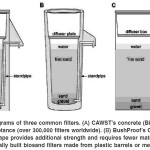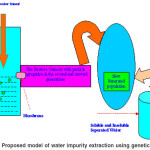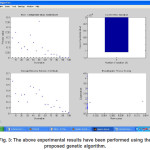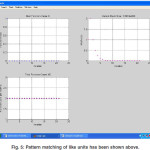Optimized Equilibrium Attention of Impure and Pure Agents Between High Concentrated Particles and Low Concentrated Particles in Reverse Osmosis Using the Principles of Genetic Algorithm
Saurabh Mukherjee¹, Nitin Paharia¹ and Ritu Tiwari²
¹Department of Computer Applications, Prestige Institute of Management, Opp.Deen Dayal Nagar,Airport Road, Gwalior - 474 020 (India).
²Department of Computer Applications, IITM,Sitholi road, Gwalior (India).
Article Publishing History
Article Received on :
Article Accepted on :
Article Published :
Article Metrics
ABSTRACT:
Drinking water is known as another life for any living being. For rest of the animal they have the natural separators to separate the pollutant and the safe material, but for human it is not so. Safe drinking water is a big problem area in Indian and other developing countries. Due to massive pollution present in drinking water, it becomes immensely important to find a cost effective solution for the safe drinking water. Various Public water treatment plants are doing well in this task but there is a huge gap between the demand and supply. Even if the water underwent through treatment, it is always questionable whether it is safe to drink or not. Various private sector jumps in the market claiming to give safe and soft drinking water. Some private players are doing well but cost still plays a big factor to reach common person. The present paper is an attempt to propose a novel model to clean the dirty water with some constraints in a specified domain.
KEYWORDS:
Drinking water; Osmosis; Genetic Algorithm
Copy the following to cite this article:
Mukherjee S, Paharia N, Tiwari R. Optimized Equilibrium Attention of Impure and Pure Agents Between High Concentrated Particles and Low Concentrated Particles in Reverse Osmosis Using the Principles of Genetic Algorithm. Orient. J. Comp. Sci. and Technol;3(1)
|
Copy the following to cite this URL:
Mukherjee S, Paharia N, Tiwari R. Optimized Equilibrium Attention of Impure and Pure Agents Between High Concentrated Particles and Low Concentrated Particles in Reverse Osmosis Using the Principles of Genetic Algorithm. Orient. J. Comp. Sci. and Technol;3(1). Available from: http://www.computerscijournal.org/?p=2193
|
Introduction
Water is another name of life for any living beings. We always crave for safe and healthy drinking water. With the volume of pollution increases day by day, the need and importance to purify the water is also increases with the passage of time. Many scientific experiments are being conducted on a regular basis, but still the cost effective way is far in reach for a common person. The present paper attempts to propose a novel model and will try to simulate the model to get valid results in the processes of having safe and soft drinking water. Water in any form is a source of life but it has to be pure. Purification process of water was started long before. With the massive industrialization, the ratio of pollutants in water goes on increasing day by day. Distillation was the process used in the early years for the purification of water.
The process was costly and required a volume of energy. Due to its old technology added with cost and energy, scientists started to find out new techniques to purify the water. The most important problem for water purification is the water source. Water is coming from various sources and each and every source carries different types of pollutants which firstly have to be detected and need process to remove it without sacrificing the originality of water contents. Sea is a big source of water but it has to be desalinated before its use as a drinking water. Distillation was the process used in this for more than five decades. But due to its certain disadvantages the process needs further review. The force of water was well understood and the process of OSMOSIS was discovered. This gave altogether a completely new dimension in the field of water purification which is called REVERSE OSMOSIS. The process proved to be a fundamental milestone and adopted commercially .Still the cost of the process need to be monitored. With this in mind the present paper is going to attempt to use the power and basic principle of genetic theory for process building which in turn will attempt to optimize the overall cost of the unit. The moral of every scientific research is that it use be useful for the society, in this footprint we have conducted the research task.
The paper is organized as follows
Section 1 introduces the conventional process of cleaning the water. Section 2 deals with brief literature review emphasizing on the need for purification of drinking water. Section 3 proposes the optimized novel model for the cleaning of the water for drinking purpose using genetic algorithm. Section 4 gives the experimental results. Section 5 gives the discussion and future research.
Literature Review
Various efforts throughout the world are on for purifying the water as it is the only source with no alternative. Water purification process covers not only the developing countries like India, Pakistan, Nepal, Bhutan etc. but also in developed countries like Great Britain Portugal, Spain etc.
Water purification is the process in which you take contaminated, dirty water and cycle it through a series of filters to clean and sterilize it [Brian et.al, 2005]. Inadequate access to safe water and poor sanitation infrastructure contribute to an estimated 1.87 million deaths per year from devastating diarrhea diseases, mostly among children less than five years of age in the developing world. But, according to a new study [1] released in the April issue of the American Journal of Tropical Medicine and Hygiene. Approximately 1.1 billion people in rural and peri-urban communities of developing countries do not have access to safe drinking water. The mortality from diarrhea-related diseases amounts to 2.2 million people each year from the consumption of unsafe water. Most of them are children under 5 years of age—250 deaths an hour from microbiologically contaminated water [Michael Lea]. The following three filters were proposed by Micheal Lea with different Biostand filters.The fig.1A is a simple Biostand which has a wide range of acceptability but due to its volume and shape it is not compatible to the changing world. The fig.1B is the upper variant of fig. A in which the total cost was reduced about 30% in terms of material used. The third figure i.e, 1C was even cheaper with the use of plastic barrels.The review shows one common factor and that is erg to reduce the overall COST with improved quality of purification.
In locations where considerable amounts of marginally polluted water are seen in the drain channels, efforts have been made to recycle this wastewater for uses of lesser importance. Eco-friendly natural treatment methods – to include, for example, decentralized wastewater treatment systems – are employed for this purpose [Whiteman et.al]. According to CII seminar held in June, 2009, they focus some prime issues related to the treatment of water. According to them, Impurities in Water are of two type’s namely suspended solids and dissolved solids. Suspended solids consists of the following
- Turbidity
- Silt
- Colloids
- Organics
Dissolved solids consists of the following
- Inorganic
- Organics
- Silica
Apart from presenting various latest techniques for purifying water, they have also presented the technologies used in ION EXCHANGE (India) Limited.
Proposed Optimized Model Using Genetic Algorithm
After basic discussion in the first two sections, let us directly come to the core part of our present research. We are going to use REVERSE OSMOSIS for the purification of water using optimization with genetic algorithm.
The molecules of the impure elements normally move from lower concentration to the higher concentration. This is the way osmosis works. While in the reverse osmosis the reverse is true i.e., water flows from higher concentration to lower concentration zone. The proposed model has been optimized in the semi-permeable membrane. It is the semi-permeable membrane where we have designed the optimization. Algorithm for the optimization of semi-permeable membrane using genetic algorithm.We assume that the impure and pure agents must be passed through the membrane. We choose random water sample and passed it through the membrane where the like genes are passed into the next generation. The selection is done from the population and then crossover is done. The new offspring get better chance of survival to get into the next generation.
The generic structure and function of reverse osmosis using genetic algorithm is as follows:
The membrane interface has been upgraded. The new offspring’s give better chances of survival. The particle segregation has been done from second generations onwards.
The proposed algorithm is as follows:
Initial population is chosen (the set of semi-permeable membrane) Set up a threshold value which acts as a terminating condition
The fitness function of each individual membrane is computed
Repeat
Choose the initial population
Sample membrane has been coded using binary stream
50 odd pairs of chromosomes have been taken in selection process
Elite children has been preserved as such All the best suited samples placed in the mating pool
Crossover has been done taking various crossover sites
Mutation has been done with 1.3% some of the newly generated population
The new offspring’s are having better chance of survival than its previous generation Until (fitness value surpass a threshold value (min or max))
The newly generated population has a higher rate of survival than it’s previous ones. The semi permeable membrane resulted in a better way with those of without using genetic algorithm.
Experimental Results and Discussions:
Fig. 2 shows Optimized equilibrium attention of impure and pure agents. The RED worm shows the behavior of normal membrane used in the process of reverse osmosis. The dark BLUE worm gives the rate of improvement as the number of generation increases in the genetic algorithm. The impurities get segregated into this process and the fresh particle (pure) comes in the next generation.
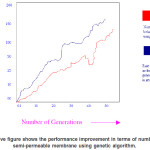 |
Figure 2: The above figure shows the performance improvement in terms of number of units in semi-permeable membrane using genetic algorithm
Click here to View figure
|
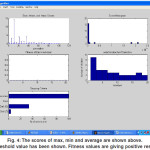 |
Figure 4: The scores of max, min and average are shown above. The threshold value has been shown. Fitness values are giving positive response
Click here to View figure
|
Conclusion and Future Research
The present experiment shows promising results. The role of the semi-permeable membrane has been understood and worked on it. With the increase in number of generations more and more like candidates emerged as an offspring and the chance of improvement in the level of unit has been evident in the experimental results. Pattern matching has been done as shown in the experimental work. The role of semi-permeable membrane plays a pivotal role in removing the impurities. The TDS (Total Dissolved Solids) level using the above mechanism could be improved. The authors will try to impart neural networks in this regard along with the use of genetic algorithm. The combined approach gives much better probability for the optimization of TDS value in water.
References
- Bruzunis, B.J. Intermittently Operated Sand Filtration: A New Water Treatment Process. Master of Engineering Thesis, Department of Civil Engineering, University of Calgary,Calgary, Alberta, Canada (1995).
- Household water treatment: Case studies from Whitman Direct Action’s “Water Book”
- Catherman, R. Using Ultraviolet to Disinfect Household Drinking Water. EDRIX,Woodinvale, Wash (2006).
- Centre for Affordable Water and Sanitation Technology. Biosand Filter Manual: Design,Construction, and Installation. CAWST.Calgary, Ontario, Canada (2008).
- Conant, J. Water for Life: Community Water Security. Hesperian Foundation,Berkeley, Calif.Availablefrom:http://www.energy and environment .undp.or g/undp/inde.cfm?module=Library&page=Document & DocumentID =5637 (2005).
- Ellms, J.W. Water Purification, 2nd ed., McGraw-Hill, New York (1928).
- Fisher, M.B., Keenan, C.R., Nelson, K.L., and Voelker, B.M. Speeding up solar disinfection (SODIS): Effects of hydrogen peroxide, temperature, pH, and copper plusascorbate on the photoinactivation of E. coli. J. Water Health 6:35-51 IWA Publishing (2008).
- doi:10.2166/wh.2007.005. Availablefrom: http://www.iwaponline.com/jwh /006/ jwh0060035.htm.
- Muhammad, N., Ellis, K., Parr, J., and Smith, M.D. Optimization of slow sand filtration. Reaching the unreached: Challenges for the 21st century (1996).
- 22ndWEDCConference, pp. 283-285. National Small Flows Clearinghouse. (1997).
- Ngai, T., Dangol, B., Murcott, S., and Shrestha, R.R. Kanchan Arsenic Filter (2006).
- Massachusetts Institute of Technology (MIT) and Environment and Public Health Organization (ENPHO). Kathmandu, Nepal. Nath, K.J., Bloomfield, S.F., Jones, M. (2006).
- Householdwater storage, handling and point-fuse treatment. A review commissioned by IFH;published on http://www.ifh-homehygiene.org.
- Rau, R. Complex simplicity: A slow sand filter for drinking water. Home Power 93:52-56 (2003).
- Smethurst, G. Basic Water Treatment: For Application World-Wide. Thomas Telford, London (1992).
- Schmidt, W. and Cairncross, S. Household water treatment in poor populations : is there enough evidence for scaling up now? Environmental science & technology ;43(4):986–992 (2009).

This work is licensed under a Creative Commons Attribution 4.0 International License.
